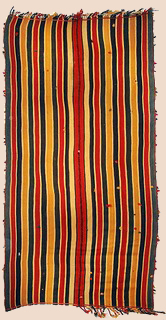Nomadic Jajims: Transcaucasian/Azarbayjani and Lur, Qashqa’i and Chahar Mahal examples

Mike Tschebull
Monday, December 3, 2018
Coffee House Club Lecture / Dinner
Jajims, which are warp-faced textiles, have been used extensively by Transcaucasian/Azarbayjani nomads, transhumants, villagers and the urban elite as pack covers, padded seating, covers for stacked up bedding in village houses during the day. When woven with silk, they are quilt tops and yard goods. I will illustrate my talk using powerpoint, showing primarily 19th century jajims, especially warp-substitution pieces, but will include Iranian Lur, Qashqa’i and Chahar Mahal examples, as well as images of objects that date warp-faced weaving back a long way.
Mike Tschebull is a long term collector of Transcaucasian and East Azarbayjani village rugs and nomad flatweaves. He is president of the Near Eastern Art Research Center, past ACOR Board member, and is particularly interested in color, how designs evolve, and why structure matters.
